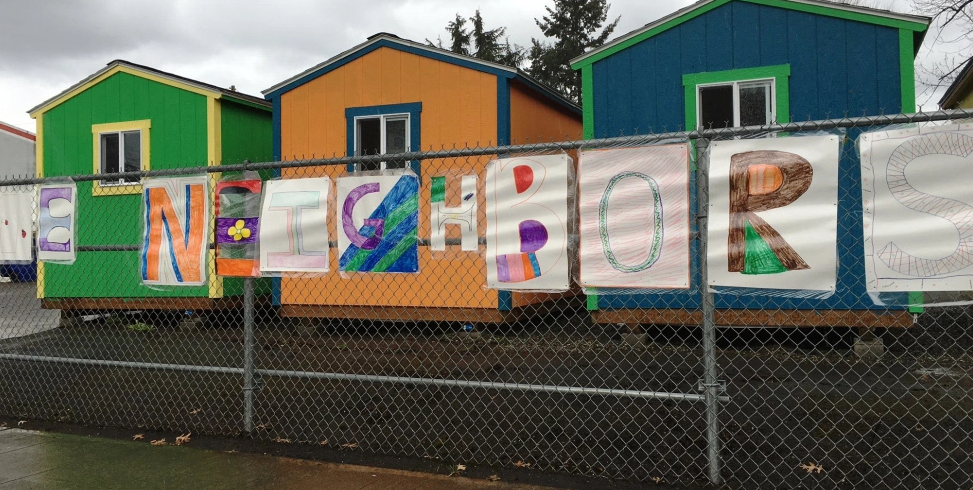We received many questions about tiny houses recently in our website survey, on our social media and on the Community Workspace on Homelessness. This is part one of a three-part Homeless Hub series on this topic. Over the next two weeks, we will publish three blog posts that consider the rise of tiny houses in Canada and abroad.
This question came from Lesley W. via our latest website survey: “Are there any Canadian examples of ‘tiny houses’ being used as social housing and if so, how's that going?”
Tiny houses are a growing trend in North America, marketed as more affordable, eco-friendly and sustainable housing that has been featured in magazines and home renovation shows for the past few years. In the summer of 2015, Tiny House Fest cropped up in Quebec, featuring many of the countless Canadian building companies who offer custom-made units.
Given the relatively low cost of tiny houses (anywhere between $30,000 and over $100,000, depending on customization, size and materials used) to traditional housing, many people have wondered if tiny houses can be used as social housing. As a very new phenomenon, there’s no extensive research on the subject, but there are a few examples of tiny houses being considered as solutions to poverty and homelessness.
In Seattle, the Low Income Housing Institute built 14 very tiny houses on church-owned property for people experiencing homelessness. (Some houses from the Othello Village site are pictured right.) Each unit was built for $2,000 USD and most were suitable for only one person, though the largest was intended for a family. The homes are transitional in nature and caseworkers are provided to help with securing food, helping people find other homes, and other services. A city councillor in Victoria pitched a similar model to address the growing number of people setting up tents in the city. Microhousing Victoria is currently in the planning and consultation phase.
Some challenges of tiny housing
Aside from being a relatively new phenomenon, there are many reasons why tiny houses are not being used as social housing.
- Land. Tiny house are cheaper than conventional housing, sure, but land is still costly and hard to secure in many urban areas. Doing so would require the ability to purchase large lots, or creating partnerships with existing owners who can also help establish needed infrastructure.
- Area bylaws. Some tiny houses require special permits, depending on the area.
- Living in a tiny house is very different than living in conventional housing and isn’t suitable for everyone. Tiny houses are not necessarily better than sleeping on the streets or in a shelter for someone who has issues being in small spaces, or families who simply needs more room. There is little flexibility or choice offered in a few square feet.
- Cost. The most livable tiny houses still cost much more than what the average person experiencing homelessness could afford, and the models still exist primarily for people who already have some wealth experience the satisfaction of “paring down.” And as Erin Anderssen wrote in The Globe and Mail, many of the people who experiment with tiny house living eventually move into bigger spaces, or admit that they can’t stay in their small houses for long periods of time.
Tiny houses demand a radically different style of living that includes reduced dependence on modern plumbing, electronics, and other “creature comforts” that many people – even those experiencing homelessness – have become accustomed to. Any social housing project using the model would have to keep this mind and offer it as an option only to those who would be interested in that kind of living.
Ultimately, tiny houses are not currently a great out-of-the-box solution to homelessness. Last January, Michael Stewart wrote in rabble that “there is…something deeply troubling about holding up a rarefied, consumer-driven living experience as some kind of ‘solution’ to a deep-seated social problem.” While more housing options are always needed, what is needed more is housing that people can stay in for as long as they need it (permanent), and is liveable and cost-effective. Most importantly, we must also look to preventing homelessness and investing in the social and economic infrastructure that makes that possible.
Next week, Ilyana Keohane, our Communications Officer, will answer: “Should we look at the Tiny Housing Movement as an option for the ever widening gap in affordability?” in part two of this series.
In part three, we would like to feature your thoughts on the tiny house movement. We encourage you to share your feedback with us on Facebook, Twitter or the Community Workspace on Homelessness, an online forum to discuss homelessness in Canada.
This post is part of our Friday "Ask the Hub" blog series. Have a homeless-related question you want answered? E-mail us at thehub@edu.yorku.ca and we will provide a research-based answer.
Photo credit: The Low Income Housing Initiative, Seattle


